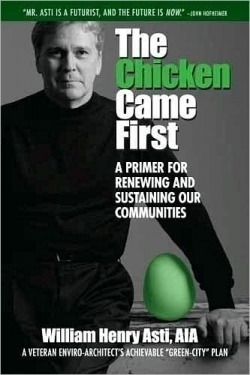The Chicken Came First
A Primer for Renewing and Sustaining our Communities
We are all chickens. This is what William Henry Asti is saying in The Chicken Came First: A Primer for Renewing and Sustaining Our Communities. A long-time architect with a passion for sustainable development, who trained under a student of Frank Lloyd Wright, Asti unleashes his philosophy of the unlimited human potential to create a livable world. He answers the age-old question ’Who came first—the chicken or the egg?“ by declaring that the former came first. Humans are the chickens, and the eggs—the concepts and institutions that humans create—are created through human actions. The author rejects the notion that people need to continue to accept business as usual, stating up front that, “We bow-down to institutions which have, in some cases, outlived their usefulness … that have become entities working in direct conflict to our efforts to survive far into the future.”
Asti goes on to systematically lay out a framework for thinking about a sustainable future: Basics, Past, Present, Future, and Developing a Model. Each section gives a detailed catalog of issues to consider in an effort to create a more sustainable society; modernity, politics, economics, problem-solving strategy, efficiencies, climate change, health care, and land use policy are just some of the things discussed. True to his background, Asti especially shines in the last section, where he provides basic training for those working in community development who are eager to incorporate sustainability of economic, environmental, and social equity. Using the redevelopment of the historic Central High Neighborhood in Little Rock, Arkansas (the famous 1957 site of Central High School’s forced integration) as an aexample, Asti walks readers through the components of recreating the complex social fabric of a neighborhood and ultimately, the nation.
Readers may object to the author’s sometimes confrontational tone throughout the book, which he notes is a purposeful effort to draw attention to certain issues. In addition, there are times when more careful organization would bring more clarity to the lessons being taught (it may help to read the last section first). However, despite this, the author’s enthusiastic assertion—that humans still continually shape their societies through their choices and actions—is a compelling and desperately needed message that will be appreciated by thoughtful citizens and students of the community development arts (urban planning, policy, and architecture). It lies in a fundamental belief that humans are vastly creative and can use that creativity to create new types of eggs…good, modern, sustainable eggs.
Reviewed by
Gabriela Worrel
Disclosure: This article is not an endorsement, but a review. The publisher of this book provided free copies of the book and paid a small fee to have their book reviewed by a professional reviewer. Foreword Reviews and Clarion Reviews make no guarantee that the publisher will receive a positive review. Foreword Magazine, Inc. is disclosing this in accordance with the Federal Trade Commission’s 16 CFR, Part 255.

